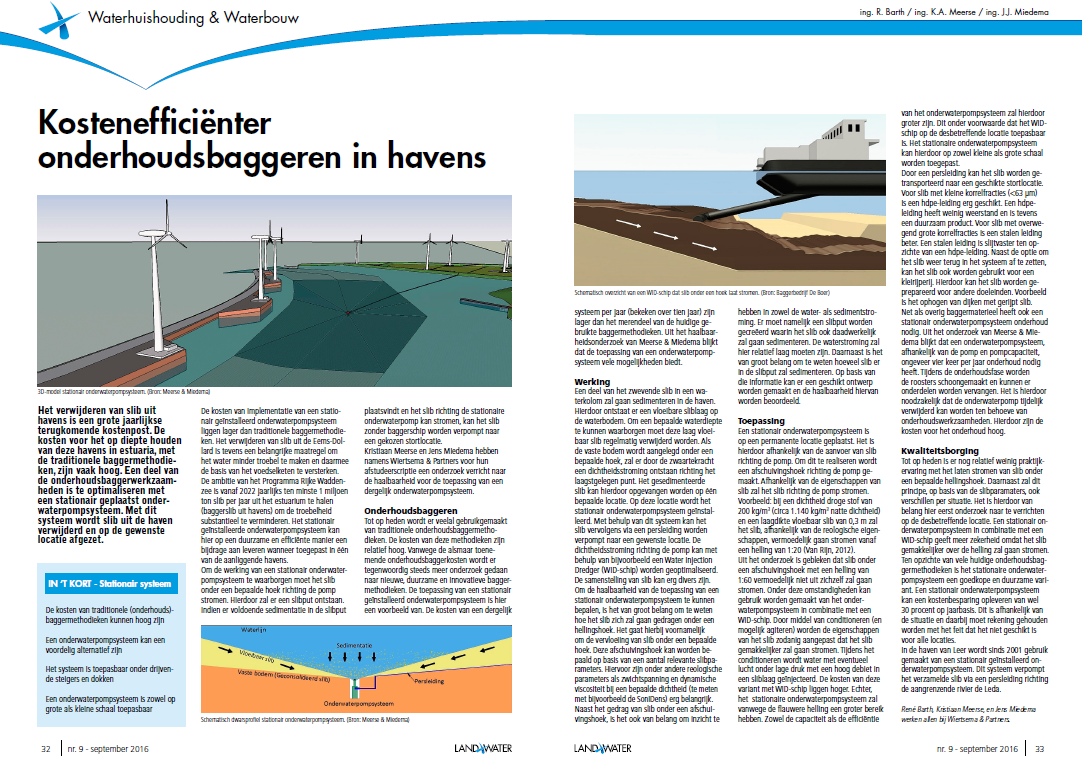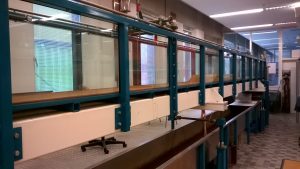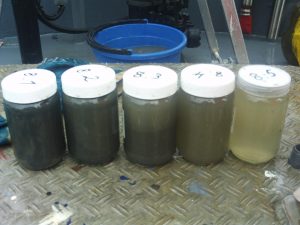Het verwijderen van slib uit havens is een grote jaarlijkse terugkomende kostenpost. De kosten voor het op diepte houden van deze havens in estuaria, met de traditionele baggermethodieken, zijn vaak hoog. Een deel van de onderhoudsbaggerwerkzaamheden is te optimaliseren met een stationair geplaatst onderwaterpompsysteem.Met dit systeem wordt slib uit de haven verwijderd en op de gewenste locatie afgezet.

Students Hanze University investigate the erodibility of mud for SEMASO B.V.
Two students from the Hanze University in Groningen will investigate the erodibility of estuarian mud for their thesis.
Dredging the ports and entrance channels in the Waddensea estuary is an ongoing business to keep them accessible for vessels. This dredging is very expensive and sometimes the effect is unfortunately very temporarily: already after one storm the channel could be silted up again. A structural, cost saving and sustainable solution should be found for the silttaion problem of ports and entrance channels in estuaries. A so called ‘flush lake’ could be an ideal solution.
A ‘flush lake’ is a lake which is filled up and emptied due to the tidal difference. With high tide the ‘flush lake’ is filled and with low tide the ‘flush lake’ is emptied. The emptying of the ‘flush lake’ creates a flush through the port or channel and the erosion of the mud will be transported out of the area. This natural solution does not require much maintenance, it can be fully automated and less dredging is required.
The students will use the waterflume of the Hanze University to determine the erodibility of mud under varying water currents.
For more information please contact BSc. René Barth (r.barth@semaso.com).
Baggervolumebepalingen
Uw reactie gevraagd op ontwerp-Richtlijn Baggervolumebepalingen, versie 2.
Het laatste jaar is door experts uit de sector hard gewerkt aan een nieuwe versie van de Richtlijn Baggervolumebepalingen op basis van handmatige metingen. Het resultaat, de ontwerpversie 2 van de Richtlijn Baggervolumebepalingen mag er dan ook zijn, vindt SIKB.
Het Centraal College van Deskundigen Bodembeheer heeft de ontwerp-wijziging vrijgegeven voor een openbare reactieronde. In aanvulling op de kennis en ervaring die de experts hebben ingebracht is ook uw input onmisbaar bij het opstellen van deze nieuwe versie van de richtlijn. Daarom nodigt SIKB u en alle andere belanghebbende partijen van harte uit om te reageren op dit ontwerp.
Wat is anders in deze nieuwe versie? In deze versie is gekozen voor een meer informerende insteek van de tekst. De teksten zijn bovendien verduidelijkt, bijvoorbeeld op de meetbare criteria, omdat dit een belangrijk aspect is van baggervolumebepalingen. Verder zijn in de richtlijn de resultaten verwerkt van het validatieonderzoek dat heeft plaatsgevonden in 2015. Over dit validatieonderzoek kunt u meer lezen op de website van SIKB. Elektronische technieken voor het meten van baggervolumes vallen nu ook binnen de reikwijdte van de richtlijn. Daarnaast zijn op de onderwerpen rolverdeling, meetintensiteit, plaatsbepaling en verificatiemetingen de nodige aanpassingen doorgevoerd.
U kunt tot uiterlijk 1 september 2016 reageren op het ontwerp-Richtlijn Baggervolumebepalingen.
Algemene informatie
De volledige tekst van het ontwerp-richtlijn is hier te vinden. Het ontwerp kan u ook tegen betaling worden toegezonden. U kunt uw commentaar op het ontwerp tot uiterlijk 1 september 2016 sturen aan info@sikb.nl.
Rijpingsfactor baggerspecie
Ripening is primarily aimed for dewatering and structureimprovement, by physical and chemical processes. In this proces also (chemical or) biological oxidation of organic micropollution occurs, but this is not the main purpose of this technique.
A measurement of the physical ripening is the ripeningsfactor ‘n’. De ripeningfactor of sediment is not only determined by the amount of watercontent, but is also dependent of the clay content and the organic content. These parameters are used in a formula to calculate the ripeningfactor (Source: Bodemtichtlijn.nl).
Semaso B.V. has the knowledge and laboratory equipment tot determine the ripeningfactor of dredged sediment.
| Ripening factor n | Indication | Description of the consistency; |
| < 0,7 | fully ripened | stive, does not stick to the hands and can not be pushed through the fingers |
| 0,7 1,0 | nearly ripened | fairly stive, sticks a little bit to the hands and can not be easily be pushed throuh the fingers |
| 1,0 1,4 | half ripened | fairly weak, sticks to the hands and is easily pushed through the fingers |
| 1,4 2,0 | nearly unripened | weak, sticks strongly to the hands and is easily pushed through the fingers |
| > 2,0 | unripened | very weak, runs almost instantly through the fingers |
(Source: Bodemrichtlijn.nl)
SEMASO Leaflets
New SEMASO leaflets can be downloaded on this site:








